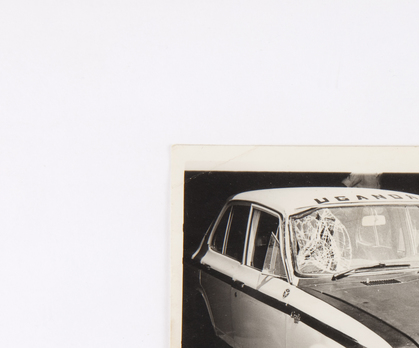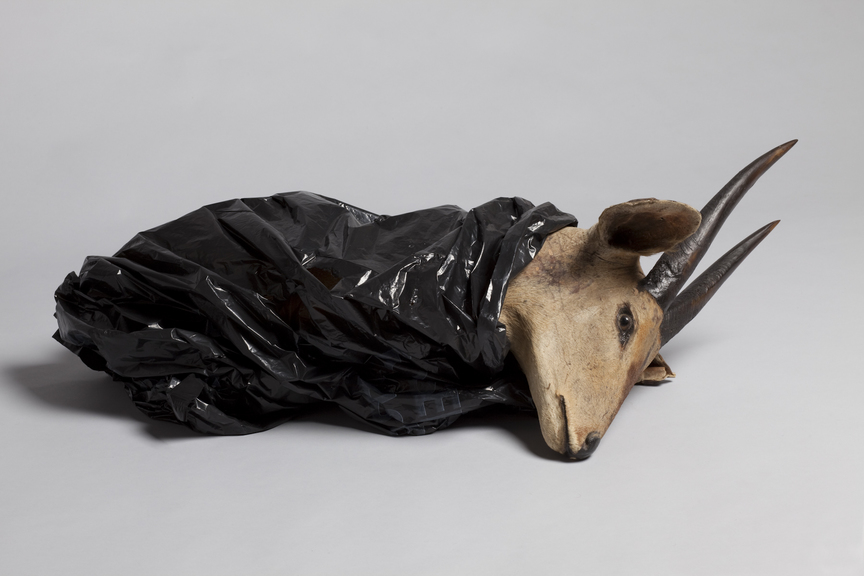-
From Current Issue
-
- Editor’s Letter Fire in the Heart
- Reviews I Gusti Ayu Kadek Murniasih
- Reviews 11th Seoul Mediacity Biennale: “One Escape at a Time”
- Dispatch Networked China
- One on One Monira Al Qadiri on Yukio Mishima
- Essays The rise of independent art spaces in pandemic-era Shanghai
- Features Tuan Andrew Nguyen
- Table of Contents
- Web Exclusives
- Archive
- Subscribe

R
E
V N
E
X
T
Installation view of SUNIL SHAH’s “Uganda Stories” at Pitt Rivers Museum, Oxford, 2018. All images courtesy the artist.
Tucked within the Pitt Rivers Museum, founded in 1884 by archaeologist General Pitt Rivers and geared towards archaeological and ethnographic artifacts, is the modest Special Exhibitions gallery where “Uganda Stories” was installed. The show is Oxford-based artist and curator Sunil Shah’s personal artistic project that attempts to recover familial narratives of loss, while experimenting with the photographic document.
Confronting the opacity of images—in that they can never reveal a full account of what they capture—and the impossibility of recovering entire, intact and impartial histories, Shah works with fragments—visual, material and anecdotal—in a methodology he has termed “post-photography.” The artist rejects the notion that the image is intrinsically authentic or authoritative; for Shah, who created the image and how are less important than the ways in which meaning is drawn from the image in a form of parafiction that weaves together the personal and the political. In his restrained reconstruction of his family history, Shah illustrates these entanglements without negating the collective trauma of his kin on their exile from their home of Uganda—along with 80,000 other Asian-Ugandans—due to dictator Idi Amin’s racist policy.
Using source material from the personal archives of Shah’s father and uncles, the artist’s manipulated photographic works offer intriguingly incomplete visual information that is understatedly wrenching. These seemingly disconnected, framed images are all untitled, from the series “Family Stories” (2012). In one, a young girl stands against a row of hedges, facing what looks like a cage, holding a leash to something we can no longer see as the section has been torn out—a violent gesture disturbing the ordinariness of a family photograph. In another, an unidentified man in a long-sleeved formal shirt, who might be an educator or municipal worker, contemplates the map of Africa mounted on a brick wall—perhaps reflecting on the historical migrations of Asians via indentured service to the British colonial government. A third shows a windscreen, shattered on the driver’s side of what looks like a taxi with “Uganda” painted on its roof, locating site and context for the viewer, and implying public disorder, violence and trenchant nationalism. Similarly suggestive of group-based exclusion is a photograph featuring a row of disembodied legs belonging to a group of various heights, and, by implication, gender and ages, standing by the word “NO.”
The true horrors of Shah’s family’s experiences in Uganda before being forcibly expelled are articulated in their testimonies, emblazoned as wall text. Some of the quotes are sparsely detailed but quietly terrifying, speaking of robberies, violence, rape, and how a family friend was hanged. The sense of trauma is also encapsulated in the objects on display in vitrine cases, recalling anthropological displays of violent death. Reification III (2015) is composed of a taxidermied antelope head staring blindly out of a scrunched-up garbage bag—simultaneously a sickening trophy and a discarded relic. In the glass-encased installation Redux (2018), Shah layers images on top of tombstone-like boxes, obscuring visual information while offering unnerving suggestions through cryptic and evocative juxtapositions. For example, an image fragment depicting hands holding the Ugandan flag is laid on top of a landscape shot of coast-side dwellings and boats, rising from or sinking into the murky waters, indicating ambiguity as to the future of the newly independent state.
The exhibition re-situates objects and images as not just artifacts to look at but as wellsprings of untold stories. From within the Pitt Rivers Museum, these different hidden histories embedded in artifacts from various cultures track pathways across the world, uncovering shared experiences of conflict, subjugation and escape. In an era of increasing global political and social segregation, “Uganda Stories” hints at these stories with sensitivity, eliciting a reflective empathy from viewers that is now more critical than ever.
The exhibition period of Sunil Shah’s “Uganda Stories” has been extended. It is on view at the Pitt Rivers Museum, Oxford, until September 23, 2018.
To read more of ArtAsiaPacific’s articles, visit our Digital Library.





